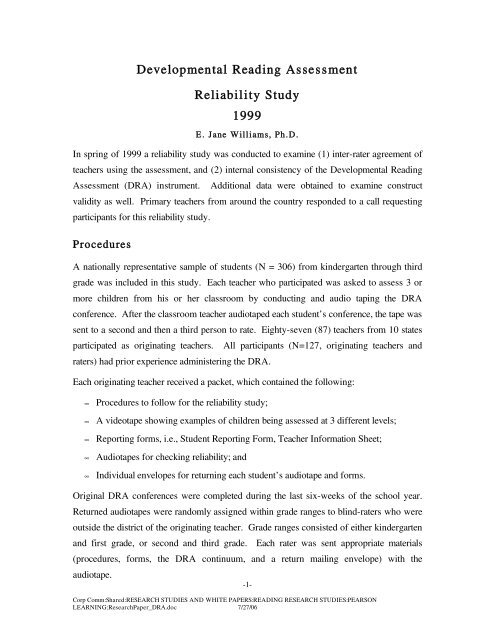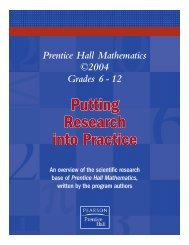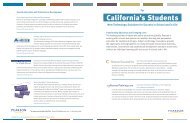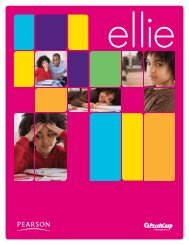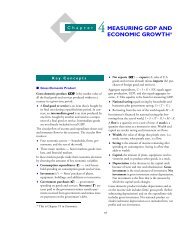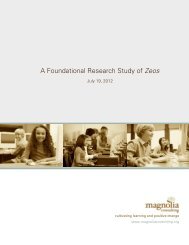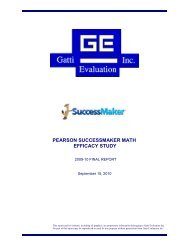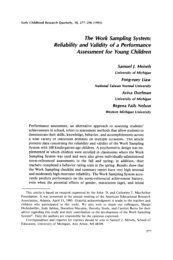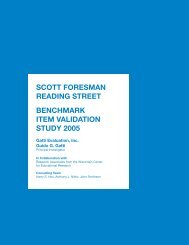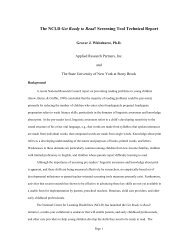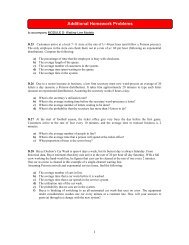Developmental Reading Assessment Reliability Study 1999 - Pearson
Developmental Reading Assessment Reliability Study 1999 - Pearson
Developmental Reading Assessment Reliability Study 1999 - Pearson
You also want an ePaper? Increase the reach of your titles
YUMPU automatically turns print PDFs into web optimized ePapers that Google loves.
<strong>Developmental</strong> <strong>Reading</strong> <strong>Assessment</strong><strong>Reliability</strong> <strong>Study</strong><strong>1999</strong>E. Jane Williams, Ph.D.In spring of <strong>1999</strong> a reliability study was conducted to examine (1) inter-rater agreement ofteachers using the assessment, and (2) internal consistency of the <strong>Developmental</strong> <strong>Reading</strong><strong>Assessment</strong> (DRA) instrument. Additional data were obtained to examine constructvalidity as well. Primary teachers from around the country responded to a call requestingparticipants for this reliability study.ProceduresA nationally representative sample of students (N = 306) from kindergarten through thirdgrade was included in this study. Each teacher who participated was asked to assess 3 ormore children from his or her classroom by conducting and audio taping the DRAconference. After the classroom teacher audiotaped each student’s conference, the tape wassent to a second and then a third person to rate. Eighty-seven (87) teachers from 10 statesparticipated as originating teachers. All participants (N=127, originating teachers andraters) had prior experience administering the DRA.Each originating teacher received a packet, which contained the following:∞∞∞∞∞Procedures to follow for the reliability study;A videotape showing examples of children being assessed at 3 different levels;Reporting forms, i.e., Student Reporting Form, Teacher Information Sheet;Audiotapes for checking reliability; andIndividual envelopes for returning each student’s audiotape and forms.Original DRA conferences were completed during the last six-weeks of the school year.Returned audiotapes were randomly assigned within grade ranges to blind-raters who wereoutside the district of the originating teacher. Grade ranges consisted of either kindergartenand first grade, or second and third grade. Each rater was sent appropriate materials(procedures, forms, the DRA continuum, and a return mailing envelope) with theaudiotape.Corp Comm:Shared:RESEARCH STUDIES AND WHITE PAPERS:READING RESEARCH STUDIES:PEARSONLEARNING:ResearchPaper_DRA.doc 7/27/06-1-
Upon return of the second rating, the tape and new materials were then mailed to a thirdgroup of blind-raters. Again each group of blind-raters was randomly assignedconferences originating outside their district. Sixteen (n=16) originating teachers plus 40new teachers served as second and third raters.Participants. Participating teachers were from eleven states and 42 districts. Ofthe 127 teachers, 10 taught kindergarten, 38 taught first grade, 24 taught second grade, 17taught third grade, and 28 taught other areas, which included reading specialists, learningdisability teachers, and literacy coordinators (10 without information). Twenty-one percentof the teachers received 2-days of training within their district, 27 percent received one-dayof training, 28 percent received a half-day training, and the remaining received various otherformats of training for the DRA. In addition, 73 percent of the teachers had administeredthe DRA 25 or more times prior to conducting the reliability assessments.Each originating classroom teacher selected three or more students of varied readingcompetencies. These students in kindergarten through third grade read assessment textsranging from level A through level 44 (a total of 20 different text levels ranging from preprimerto fifth grade). Table 1 shows the number of boys and girls who read at each DRAtext level by grade level.<strong>Reliability</strong>. To determine the extent of inter-rater agreement amongteachers/raters, Rasch rating scale analyses were conducted across 4-facets. Rasch (facet)rating scale analyses were employed to capture the multiple facets of the reading processand their interdependencies. The raters (n=3), students (n=306), text reading levels (n=19),and items (n=5) identified the facets. Items included rating scale responses indicated byteachers for students’ rate of accuracy, level of understanding (comprehension), readingstage, phrasing, and reading rate. The rating scale responses to the items are the results ofthe interactions between the facets.Cronbach’s alpha was employed to determine the internal consistency of the items and text.The item and text separation reliability in Rasch rating scale analyses are equivalent toCronbach’s alpha.Table 1. Frequency of DRA Text Levels for Children by Grade LevelCorp Comm:Shared:RESEARCH STUDIES AND WHITE PAPERS:READING RESEARCH STUDIES:PEARSONLEARNING:ResearchPaper_DRA.doc 7/27/06-2-
DRATextLevelKindergarten First Grade SecondGradeThird GradeN Boy Girl NA Boy Girl NA Boy Girl NA Boy Girl NA NAA 4 0 2 0 0 0 2 0 0 0 0 0 0 01 9 3 2 0 1 0 3 0 0 0 0 0 0 02 9 1 2 0 2 0 4 0 0 0 0 0 0 03 17 6 2 0 3 4 1 0 0 0 1 0 0 04 14 2 1 0 5 3 2 0 1 0 0 0 0 06 13 1 2 0 7 2 0 0 0 0 0 0 0 18 9 1 0 0 2 3 2 1 0 0 0 0 0 010 7 0 1 0 1 1 1 2 0 0 0 0 0 112 10 0 1 0 3 4 0 1 0 0 1 0 0 014 12 0 1 0 7 3 0 1 0 0 0 0 0 016 20 1 3 0 3 7 0 2 1 0 0 0 0 318 23 1 0 0 5 5 0 6 1 0 2 2 0 120 14 0 0 0 7 3 0 3 0 0 0 0 0 124 24 0 0 0 5 6 0 4 3 0 6 0 0 028 30 0 0 0 5 8 0 6 6 0 0 4 0 130 17 0 0 0 1 0 0 5 5 0 3 3 0 034 8 0 0 0 0 1 0 2 2 0 1 2 0 038 39 0 0 0 1 0 0 7 6 0 18 7 0 040 15 0 0 0 0 1 0 2 2 0 6 4 0 044 12 0 0 0 1 0 0 1 2 0 3 5 0 0Total 306 16 17 0 59 51 15 43 29 0 41 27 0 8OtherTeachers reported each participating student’s rate of accuracy, level of understanding(comprehension), reading stage, as well as the teacher’s evaluation of the student’sphrasing and reading rate, which was gathered during the DRA conference and recorded onthe DRA Observation Guide.Rate of accuracy was determined by counting the number of uncorrected miscues andwords given by the teacher during the oral reading of a portion or the entire text for theselected DRA text level. The accuracy rates were grouped in the following categories,where: 1 = less than 90 percent accuracy, 2 = 90 through 93 percent accuracy, 3 = 94through 97 percent accuracy, and 4 = 98 through 100 percent accuracy.Teachers judged the students’ degree of understanding based on the their retellings usingthe descriptors on the DRA Continuum. The following four-point scale represents thedegree of understanding: (1) little understanding, (2) some understanding, (3) adequateunderstanding, and (4) very good understanding, Table 2.Table 2. DRA Levels of Understanding/ComprehensionCorp Comm:Shared:RESEARCH STUDIES AND WHITE PAPERS:READING RESEARCH STUDIES:PEARSONLEARNING:ResearchPaper_DRA.doc 7/27/06-3-
Retelling represents:LittleSome UnderstandingUnderstanding∞ Unorganized ∞ Somewhat organized∞ Important details ∞ Focuses on parts rathermissingthan the whole∞∞IncorrectinformationMisinterpretation∞∞∞Events out of sequenceIncludes some detailsabout characters andeventsSome misinterpretationAdequateUnderstanding∞∞∞∞Organized butmay be choppySequential for themost partIncludes mainideas, detailsabout characters,settings, andeventsLiteralinterpretationVery GoodUnderstanding∞∞∞∞∞Effectively organizedand fluidSequentialIncludes main idea,important details aboutcharacters, settings, andeventsReveals use ofbackground knowledgeand experience tointerpret storyUses vocabulary/special phrases from thestoryStudents’ <strong>Reading</strong> Stages were identified by the teachers based on the level of the text readby the student and other descriptors circled on the DRA Continuum for (1) Emergent, (2)Early, (3) Transitional, and (4) Extending. Generally Emergent readers read DRA textlevels A to 2, Early readers read DRA text levels 3 to 10, Transitional readers read DRAtext levels 12 to 24, and Extending readers read DRA text levels 28 through 44.Teachers determined if students’ phrasing was appropriate for their reading stage ofdevelopment based on whether or not the children read word by word, in short phrases, inlonger phrases, or observing punctuation as well as if they reread to rephrase or observepunctuation. After deciding the students’ levels of phrasing, teachers then determined theextent to which they agreed the levels were appropriate for their reading stages ofdevelopment. The extent of agreement was based on the following scale, where 1 =strongly disagree, 2 = disagree, 3 = agree, and 4 = strongly agree.The same scale was used to determine if students’ reading rates were adequate for theirreading stages of development based on information checked in the DRA ObservationGuide. The descriptors for reading rate were slow, inconsistent, adequate, too fast, andadjusted appropriately. The frequency of responses by teachers/raters to the rating scaleitems is reported in Table 3.Table 3. Frequency of Responses to Items by Teachers/RatersCorp Comm:Shared:RESEARCH STUDIES AND WHITE PAPERS:READING RESEARCH STUDIES:PEARSONLEARNING:ResearchPaper_DRA.doc 7/27/06-4-
RULES AND REGULATIONSJOHN HOGANCLEAR CHANNEL RADIOGERALDINE LAYBOURNEOXYGEN MEDIA INC.KEVIN O’BRIENMEREDITH BROADCASTING GROUPSTU OLDSKATZ MEDIA GROUPJENNIFER PURTANABC RADIO NETWORKSFRANKLIN D. SCHURZ, JR.SCHURZ COMMUNICATIONS, INC.JOHN M. SHAKERBMISIR HOWARD STRINGERSONY CORPORATIONBOB WRIGHTNBC INC.MAKING WAVES EDITORIALADVISORY BOARDTERRI WALKER, CO-CHAIRKTUL-TVMARIA BRENNAN, CO-CHAIRAWRTROZ ABRAMSTELEVISION NEWS PERSONALITYPIERRE BOUVARDARBITRONCHRISTA DAHLANDERRADIO ADVERTISING BUREAULINA DUVERGELIFETIME TELEVISIONERICA FARBERRADIO & RECORDSJOAN E. GERBERDINGLAURA HAGANKATZ HISPANIC MEDIABETTY HUDSONNATIONAL GEOGRAPHIC SOCIETYREGINA KITSONKATZ MEDIA GROUPLARRY OLIVERREED BUSINESSDOROTHY POLANCOSTRATFORCAROLE ROBINSONMTV NETWORKSJAN SHARPCAPITOL BROADCASTING CO. INC.CHERYL WINERTHESTREET.COMADVERTISE INMAKING WAVES!FOR INFORMATION AND RATES, CALLAWRT AT (703) 506-3290, EXT. 7164.New Rules for Political AdvertisingBY ELIZABETH HAMMONDDuring this election year, it would behoovebroadcast stations to familiarize themselveswith the rules and regulations of politicaladvertising.In March 2002, Congress passed the BipartisanCampaign Reform Act of 2002 (BCRA)to eliminate soft-money donations partiallyin an effort to stem the rising tide of negativecampaign advertising. A number of groupschallenged this new law in the courts. OnDecember 13, 2003, the U.S. Supreme Courtdetermined that many of the more controversialBCRA sections are constitutional.BCRA affects broadcasters in several ways,establishing new requirements for candidateadvertising and station recordkeeping forsuch advertising. These new requirementsapply only to candidates for federal office, notto candidates for state and local elections.Following are some of the more significantnew requirements for broadcast stations inthe current election year.Candidate certifications: BCRA requirescandidates and/or their authorized committeesto provide written certifications to stationswhen time is purchased for a candidate spot inorder to receive the station’s lowest unit chargefor such advertising. This written statement isrequired for every purchase of time. The certificationmust state either a) the spot does notrefer to another candidate for the same officein any manner or b) the spot makes referenceto another candidate but contains an identificationand approval statement from the candidateplacing the spot. If a spot makes anyreference to another candidate without therequired identification and approval statement,regardless of the certification statementreceived by the station, the candidate forfeitshis or her rights to lowest unit charges for thatspot and for any advertising placed for theremainder of the lowest unit charge period.Any candidate spot referring to anothercandidate for the same office in any mannermust include a statement identifying the candidateon whose behalf the spot is appearingand that the candidate has approved the spot.For radio spots, at the end of the spot, candidatesare required to:● include a statement in their own voiceidentifying themselves and the office theyare seeking● state they have approved the broadcast ofthis spot and that the candidates or theirauthorized committee paid for the broadcastFor television stations, in addition to theaudio statement required for radio broadcasts,the spot must include, for a minimumof four seconds, a clearly identifiable imageor photograph of the candidate and a clearlyreadable printed statement containing thesame information as contained in the audio,including that the candidates or their authorizedcommittee paid for the broadcast. Thesame identification and approval informationis required for any candidate spot solicitingany political contribution.Third-party ads: Political advertisingadvocating the election or defeat of a candidatefor federal office or soliciting politicalcontributions that isn’t authorized by a candidateor a candidate-authorized committeemust include the following aural statementfor both television and radio spots: “Thisadvertisement is not authorized by any federalcandidate. [___________] is responsiblefor the content of this advertisement.” Theblank must be filled in with the name of thepolitical party, committee or person payingfor the broadcast, the name of any organizationconnected to the payer and a permanentstreet address, telephone number and Webaddress, if any. As with candidate televisionspots, third-party television spots mustinclude a full-screen view of a representativeof the party making the statement and, for atleast four seconds, a printed statement withthe same information.All identification statements, both candidateand third party, must be easy to hear and read.Recordkeeping: BCRA expands stations’public recordkeeping requirements for bothcandidate spots and political programmingcommunicating a message relating to anypolitical matter of national importance (forexample, health care, gun control or the warin Iraq). In addition to the information stationswere previously required to keep intheir political file, broadcasters must nowalso keep the records of the following:● each request for purchase of time● whether the station accepts or rejects therequest (in whole or in part)● the rate chargedCONTINUED ON PAGE 23AMERICAN WOMEN IN RADIO AND TELEVISION 3
Construct Validity. The study described was designed to examine the interraterreliability and internal consistency of the DRA. Subsequently, additional data wereobtained from one school district to help establish the construct validity of the DRA. Toensure that the DRA measured what was intended, the validity of the DRA instructionalreading level was assessed. To assess its validity, individual scores on the DRA for thesecond grade population (N=2470) at the end of the 1998-99 school year from a largeurban/suburban school district were correlated with the students’ scores from fall of thirdgrade on the Iowa Test of Basic Skills Subscales: Vocabulary, <strong>Reading</strong> Comprehension,and Total <strong>Reading</strong>. All correlations were significant at the 0.01 level (2-tailed) usingSpearman’s Rho rank order correlation; however, the highest and most meaningfulcorrelation for this assessment was with Total <strong>Reading</strong> (r = 0.71, p < .01) (see Table 4).Thus, since the DRA instructional reading levels demonstrated a strong correlation with theIowa Test of Basic Skills Total <strong>Reading</strong> subscale for one large urban/suburban schooldistrict, this evidence adds strength to the belief that the DRA validly measures a child’sability to decode and understand/comprehend what he/she has read. Further support isprovided by the Vermont – DRA validity and reliability report (Biggam, & Grainger,1998). Biggam and Grainger noted, “A new variation on the notion of content validity isauthenticity. Authenticity is analogous to curricular validity in the sense that with bothconcepts, a test is compared to some external standard of appropriateness…Withauthenticity, the external standards are various types of literacy tasks that people engage inacross a variety of literacy environments…The key question is, Does this test reflect theways in which we can expect students to use literacy for communication and learningCorp Comm:Shared:RESEARCH STUDIES AND WHITE PAPERS:READING RESEARCH STUDIES:PEARSONLEARNING:ResearchPaper_DRA.doc 7/27/06-6-
Table 4. Spearman’s Rho Correlations Between ITBS Subscales and DRAInstructional Levels.Spearman’s rhoRank OrderCorrelationI TBS <strong>Reading</strong>Comp NCEI TBS Total<strong>Reading</strong> NCEI TBSVocabularyNCEDRAInstructionalLevelI TBS <strong>Reading</strong>Comp NCEI TBS Total<strong>Reading</strong> NCE---- 0.953**2470**. Correlation is significant at the 0.01 level (2-tailed).I TBSVocabularyNCE0.812**2470---- 0.947**2470----DRAInstructionalLevel0.675**24700.708**24700.675**2470----purposes?” (cited by Biggam & Grainger, page 4, from Taylor, Harris, <strong>Pearson</strong>, & Garcia,1995, p. 329). The DRA is an authentic performance based assessment in which childrenare responding to real text through retelling.In addition the Vermont Department of Education and University of Vermont (with supportfrom the Northeast & Islands Regional Lab at Brown) are currently conducting a furthervalidity study on the VT—DRA (Lipson, M., Biggam, S., Connor, D., & Mekkelsen, J.,<strong>1999</strong>).Summary and DiscussionIn summary, reliability results from Rasch scale (facet) analyses revealed good to fairreliability between raters. Inter-rater agreement, as measured by rater separation reliability,was good (0.80) between the originating teacher and the second rater, while the inter-rateragreement found among all three raters was a little lower (0.74). Each of the analyses wasconducted across 4 facets (raters, students, text levels, and items) with the 5 rating scaleitems (accuracy, comprehension, stage, phrasing, and reading rate). Additional support forconstruct validity was obtained from data from Ft. Bend ISD, TX as well as from the VT –DRA statewide assessment report by the Vermont Department of Education, 1998.One might expect the reliability to be higher between the two raters who were rating theaudiotapes, than with the originator teacher, but that was not the case. Nonetheless, it is notCorp Comm:Shared:RESEARCH STUDIES AND WHITE PAPERS:READING RESEARCH STUDIES:PEARSONLEARNING:ResearchPaper_DRA.doc 7/27/06-7-
surprising that the agreement among all three raters was slightly lower than that for the firsttwo raters (originating teacher and second rater) considering that the third rater received theaudiotape and materials for analysis at the beginning of the next school year inAugust/September, whereas the second rater received the tape and materials in June/July.The third raters were pressed for time due to the additional demands of beginning a newschool year. No teachers/raters received additional training prior to conducting ratings.It should be noted that a major purpose of the DRA is to help guide instruction. Ninetyeightpercent (98%) of the teachers and raters agreed or strongly agreed to the statement thatthe information gained about the reader during the DRA conference helped them betteridentify things that the child needed to do or learn next. In a joint position statemententitled, Learning to Read and Write: <strong>Developmental</strong>ly Appropriate Practices for YoungChildren adopted in 1998 by the International <strong>Reading</strong> Association (IRA) and the NationalAssociation for the Education of Young Children (NAEYC), it is stated thatThroughout these critical years accurate assessment of children’s knowledge, skills,and dispositions in reading and writing will help teachers better match instructionwith how and what children are learning. However, early reading and writingcannot be measured as a set of narrowly defined skills on standardized tests. Thesemeasures often are not reliable or valid indicators of what children can do in typicalpractice, nor are they sensitive to language variation, culture, or the experience ofyoung children (Shepard & Smith, 1998; Shepard, 1994; Johnston, 1997). Rather, asound assessment should be anchored in real-life writing and reading tasks…p.15and should support “individualized diagnosis needed to help young childrencontinue to progress in reading and writing.” p.20Corp Comm:Shared:RESEARCH STUDIES AND WHITE PAPERS:READING RESEARCH STUDIES:PEARSONLEARNING:ResearchPaper_DRA.doc 7/27/06-8-
RecommendationsThe following steps are recommended to further strengthen the DRA’s reliability as aprimary reading assessment.1. Teachers are trained for reliability purposes using audio and videotapes. <strong>Reliability</strong>training is critical to assure that all students are evaluated based on the same criteriaand the score for one child is the same as that for another child with the sameresponses/behaviors even when evaluated by a different teacher or at a differenttime.2. To increase reliability when conducting the DRA, teachers audiotape the assessmentconference as suggested by Clay in An Observation Survey of Early LiteracyAchievement (1993, page 28).Corp Comm:Shared:RESEARCH STUDIES AND WHITE PAPERS:READING RESEARCH STUDIES:PEARSONLEARNING:ResearchPaper_DRA.doc 7/27/06-9-
ReferencesA joint position statement of the International <strong>Reading</strong> Association (IRA) and the NationalAssociation for the Education of Young Children (NAEYC). (<strong>1999</strong>). Learning toRead and Write: <strong>Developmental</strong>ly Appropriate Practices for Young Children. 20.Biggam, S., & Grainger, E. (Personal communication, March <strong>1999</strong>). Summary of findingfrom the 1998 statewide administration of the “VT-DRA.” Vermont Department ofEducation.Clay, M.M. (1993). An observation survey of early literacy achievement. Auckland, NewZealand: Heinemann.Criswell, G., & Duvall, C. (November <strong>1999</strong>). Electronic data file. Ft. Bend IndependentSchool District, Testing and Evaluation.Johnston, (1997). Knowing literacy: Constructive literacy assessment. York, ME:Stenhouse.Linacre, J.M. (1997). A user’s guide to Facets: Rasch measurement computer program.Chicago, IL: MESA Press.Lipson, M., Biggam, S., Connor, D., & Mekkelsen, J. (<strong>1999</strong>, December). Large scaleearly reading assessment: Challenges, strategies, and implications. Paper presentedat the National <strong>Reading</strong> Conference, Orlando, FL.Shepard, L. & Smith, M.L. 1998. Escalating academic demand in kindergarten: Somenonsolutions. Elementary School Journal 89: 135-46.Shepard, (1994). The challenges of assessing young children appropriately. Phi DeltaKappan 76: 206-13.Wright, B.D., and Masters, G.N. (1982). Rating scale analysis: Rasch measurement.Chicago, IL: MESA Press.-10-Corp Comm:Shared:RESEARCH STUDIES AND WHITE PAPERS:READING RESEARCH STUDIES:PEARSONLEARNING:ResearchPaper_DRA.doc 7/27/06


